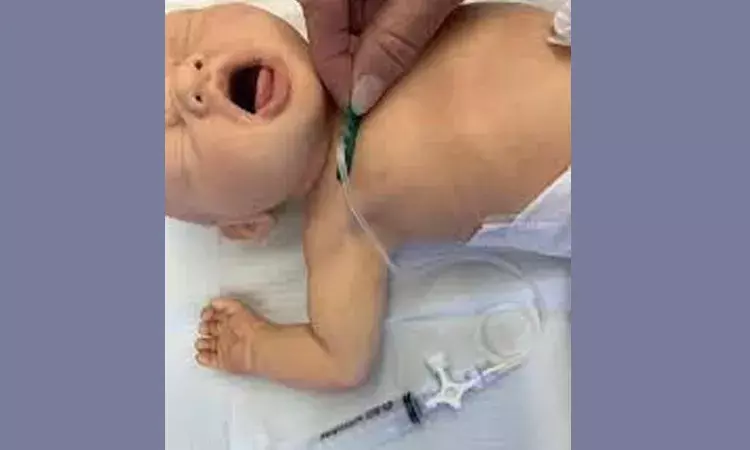- Home
- Medical news & Guidelines
- Anesthesiology
- Cardiology and CTVS
- Critical Care
- Dentistry
- Dermatology
- Diabetes and Endocrinology
- ENT
- Gastroenterology
- Medicine
- Nephrology
- Neurology
- Obstretics-Gynaecology
- Oncology
- Ophthalmology
- Orthopaedics
- Pediatrics-Neonatology
- Psychiatry
- Pulmonology
- Radiology
- Surgery
- Urology
- Laboratory Medicine
- Diet
- Nursing
- Paramedical
- Physiotherapy
- Health news
- Fact Check
- Bone Health Fact Check
- Brain Health Fact Check
- Cancer Related Fact Check
- Child Care Fact Check
- Dental and oral health fact check
- Diabetes and metabolic health fact check
- Diet and Nutrition Fact Check
- Eye and ENT Care Fact Check
- Fitness fact check
- Gut health fact check
- Heart health fact check
- Kidney health fact check
- Medical education fact check
- Men's health fact check
- Respiratory fact check
- Skin and hair care fact check
- Vaccine and Immunization fact check
- Women's health fact check
- AYUSH
- State News
- Andaman and Nicobar Islands
- Andhra Pradesh
- Arunachal Pradesh
- Assam
- Bihar
- Chandigarh
- Chattisgarh
- Dadra and Nagar Haveli
- Daman and Diu
- Delhi
- Goa
- Gujarat
- Haryana
- Himachal Pradesh
- Jammu & Kashmir
- Jharkhand
- Karnataka
- Kerala
- Ladakh
- Lakshadweep
- Madhya Pradesh
- Maharashtra
- Manipur
- Meghalaya
- Mizoram
- Nagaland
- Odisha
- Puducherry
- Punjab
- Rajasthan
- Sikkim
- Tamil Nadu
- Telangana
- Tripura
- Uttar Pradesh
- Uttrakhand
- West Bengal
- Medical Education
- Industry
Fiberoptic PT as effective as blue light PT in hyperbilirubinemia in neonates: Study

The effectiveness of fiberoptic phototherapy and blue light conventional PT were comparable in terms of bilirubin reduction rate and treatment duration, whereas fiberoptic phototherapy was more effective than white light conventional PT, with a significantly higher bilirubin reduction rate and shorter treatment duration, describes a recent study published in the BMC Pediatrics.
Neonatal jaundice is one of the most common problems in neonates. Effective treatment of jaundice requires therapeutic intervention with high quality phototherapy. Over recent years, several studies reported fiberoptic phototherapy to be less effective than conventional phototherapy in term neonates.
Therefore, Helvi N. Joel and colleagues from the Department of Paediatrics and Child Health, Kilimanjaro Christian Medical University College, Tanzania conducted the present study to compare the effectiveness of fiberoptic phototherapy with a larger illuminated area and higher irradiance to conventional phototherapy methods.
The authors carried out a randomized controlled trial conducted at the Kilimanjaro Christian Medical Centre (KCMC) with a total of 41 term neonates, less than 7 days of age with unconjugated hyperbilirubinemia. Thirteen (13) neonates were allocated to receive fiberoptic phototherapy, 13 to blue light conventional phototherapy and 15 to white light conventional phototherapy.
Effectiveness was assessed by comparing the duration of phototherapy, bilirubin reduction rate and side effects of treatment. The data was analyzed with the independent t-test.
The results highlighted that –
a. The mean overall bilirubin reduction rate was comparable in the fiberoptic phototherapy group (0.74%/h) and the blue light conventional phototherapy group (0.84%/h), with no statistically significant difference (p-value 0.124).
b. However, white light conventional phototherapy had a significantly lower mean overall bilirubin reduction rate (0.29%/h) as compared to fiberoptic phototherapy (p-value < 0.001).
c. The mean treatment duration of phototherapy was 69 h, 68 h and 90 h in the fiberoptic, blue light conventional and white light conventional phototherapy groups respectively.
d. Side effects such as loose stool and skin rash were noted in some participants who received conventional phototherapy.
e. No side effects of treatment were noted in the fiberoptic phototherapy group.
Hence, the team concluded that "the effectiveness of fiberoptic PT and blue light conventional PT were comparable in terms of bilirubin reduction rate and treatment duration, whereas fiberoptic phototherapy was more effective than white light conventional PT, with a significantly higher bilirubin reduction rate and shorter treatment duration. Fiberoptic phototherapy may mitigate side effects caused by conventional phototherapy."
Dr. Nandita Mohan is a practicing pediatric dentist with more than 5 years of clinical work experience. Along with this, she is equally interested in keeping herself up to date about the latest developments in the field of medicine and dentistry which is the driving force for her to be in association with Medical Dialogues. She also has her name attached with many publications; both national and international. She has pursued her BDS from Rajiv Gandhi University of Health Sciences, Bangalore and later went to enter her dream specialty (MDS) in the Department of Pedodontics and Preventive Dentistry from Pt. B.D. Sharma University of Health Sciences. Through all the years of experience, her core interest in learning something new has never stopped. She can be contacted at editorial@medicaldialogues.in. Contact no. 011-43720751
Dr Kamal Kant Kohli-MBBS, DTCD- a chest specialist with more than 30 years of practice and a flair for writing clinical articles, Dr Kamal Kant Kohli joined Medical Dialogues as a Chief Editor of Medical News. Besides writing articles, as an editor, he proofreads and verifies all the medical content published on Medical Dialogues including those coming from journals, studies,medical conferences,guidelines etc. Email: drkohli@medicaldialogues.in. Contact no. 011-43720751


